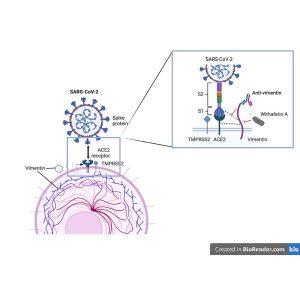According to a new study, the cell-surface protein vimentin serves as a co-receptor for the infection-promoting entrance of SARS-CoV-2 into host cells (Figure 1). Targeting vimentin may offer a special method of stopping COVID-19.
A crucial component of SARS-infectiousness CoV-2’s and disease pathogenesis is its ability to enter host cells. SARS-CoV-2 is a single-stranded enveloped RNA virus. SARS-CoV-2 principally depends on the receptor binding domain (RBD) found within the spike protein to connect to the cell’s surface ACE2 receptor and initiate viral attachment. The virus is then able to enter endosomes and combine with host-lysosomal membranes as a result.
COVID-19 predominantly produces respiratory symptoms despite low expression of ACE2 in the respiratory tract. This highlights the importance of cofactors which facilitate interactions between the spike protein and the host receptor. Vimentin is expressed by several immune cell types and other cell types such as fibroblasts, endothelial cells, macrophages, melanocytes, and more. Vimentin appears to interact with the SARS-CoV-2 spike protein, according to more recent study.
The expression of ACE2, TMPRSS288, and vimentin was examined in the current work using a range of epithelial cell lines, including Vero E6, human colon epithelial cells (Caco-2), and human alveolar basal epithelial cells (A549). The next step was to determine if the expression levels of vimentin and ACE2 in these cells were associated with SARS-CoV-2 cell entrance.
The results of this work imply that, in Vero E6 cells as opposed to the other epithelial cell lines, the expression of vimentin at the cell surface may support the greater absorption of SARS-CoV-2.
Vimentin may serve as a co-receptor for SARS-CoV-2 infection because there was no interaction between it and ACE2 in uninfected Vero E6 cells. Vimentin enhances SARS-CoV-2 cell infection.
Journal article: Arrindell, J., et al. 2022. Vimentin is an important ACE2 co-receptor for SARS-COV-2 in epithelial cells. IScience.
Summary by Stefan Botha











